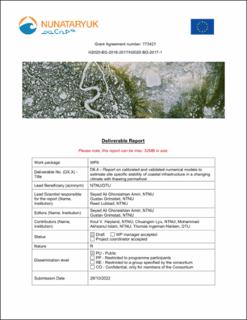| dc.description.abstract | This report presents an overview of the costal erosion model and the infrastructure stability model that are capable of predicting the site-specific response to the global warming and thawing permafrost. The models are developed/modified during the NUNATARYUK project. This report is necessary because the increased Arctic coastal erosion together with permafrost degradation pose a significant threat to the communities living close to the coasts. It provides a brief description of the models, and their calibration procedures, and demonstrates a couple of validation case studies. The costal erosion model described in this report is a comprehensive process-based model. It couples the thermodenudation and thermoabrasion processes with nearshore hydrodynamics and sediment transport. A couple of open-source packages are combined in this model with in-house models/codes to simulate the Arctic coastal erosion processes in a sequentially coupled manner. A simplified 1D storm surge module introduced by Dean and Dalrymple (1991), and the SWAN package developed at TU-Delft (TU-Delft, 2021) are employed to simulate the storm surge and wave generation in the offshore zone, respectively. The waves and related hydrodynamic forces together with sediment transport and morpho-dynamics are simulated using XBeach (Deltares, 2022). The processes related to permafrost melting and erosion of the bluffs are simulated with in-house modules implemented in XBeach. The model is calibrated and validated with field measurements from one of the Arctic coasts along the Kara Sea. The simulations confirms that the erosion mechanism is greatly influenced by the nearshore hydrodynamics and provide justification for including a hydrodynamic model to simulate Arctic coastal erosion. The coastal infrastructure stability model in this report is a thermo-hydro-mechanical (THM) constitutive model that can represent the behaviour of frozen and unfrozen soil at the representative elementary volume (REV) scale, and in a unified manner. The presented model can describe the mechanical behaviour of frozen soil, including creep, as function of temperature, up to the unfrozen sate and vice versa. The model is designed for clay material, but the idea behind the model can be extended for sand as well. The model is implemented in Plaxis package, which is a software widely used by geotechnical engineers, and is capable of simulating the coupled THM behaviour of porous media, like clay deposits, at the global scale, using the finite element (FE) method. The calibration procedure is described in the report. All model parameters can be found using laboratory tests at the REV scale. The model is calibrated and validated using the field measurements conducted in the National Geo-test Site located at Longyearbyen Svalbard, and reasonable agreements have been achieved. It is also used to simulate the permafrost degradation and settlement of a footing with various embedment depth and applied stress for different imposed warming scenarios for the next 50 years. The simulations results confirm the importance of creep deformation for the serviceability and stability of infrastructures on warming permafrost, particularly in clay deposits. | en_US |
